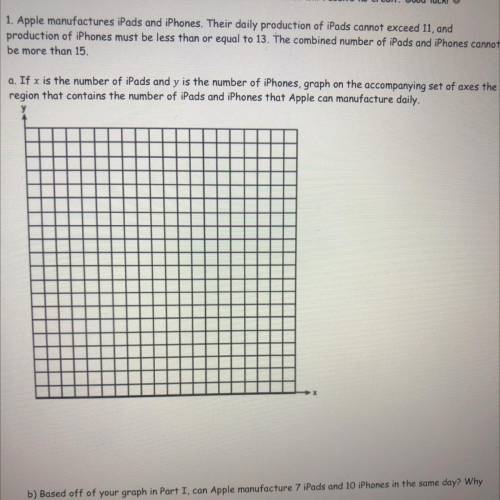
Mathematics, 15.12.2020 18:00 dogwisperer101
1. Apple manufactures iPads and iPhones. Their daily production of iPads cannot exceed 11, and
production of iPhones must be less than or equal to 13. The combined number of iPads and iPhones cannot
be more than 15.
a. If x is the number of iPads and y is the number of iPhones, graph on the accompanying set of axes the
region that contains the number of iPads and iPhones that Apple can manufacture daily.
b) Based off of your graph in Part I can Apple manufacture 7 iPads and 10 iPhones in the same day? Why
or why not?


Answers: 3


Another question on Mathematics

Mathematics, 21.06.2019 19:30
Jada has a meal in a restaurant she adds up the prices listed on the menu for everything they ordered and gets a subtotal of $42.00. after tax the total is 45.99. what percentage of the subtotal is the total?
Answers: 2

Mathematics, 21.06.2019 19:40
Neoli is a nurse who works each day from 8: 00 am to 4: 00 pm at the blood collection centre. she takes 45 minutes for her lunch break. on average, it takes neoli 15 minutes to collect each sample and record the patient's details. on average, how many patients can neoli see each day?
Answers: 3


Mathematics, 21.06.2019 22:30
Amachine that produces a special type of transistor (a component of computers) has a 2% defective rate. the production is considered a random process where each transistor is independent of the others. (a) what is the probability that the 10th transistor produced is the first with a defect? (b) what is the probability that the machine produces no defective transistors in a batch of 100? (c) on average, how many transistors would you expect to be produced before the first with a defect? what is the standard deviation? (d) another machine that also produces transistors has a 5% defective rate where each transistor is produced independent of the others. on average how many transistors would you expect to be produced with this machine before the first with a defect? what is the standard deviation? (e) based on your answers to parts (c) and (d), how does increasing the probability of an event a↵ect the mean and standard deviation of the wait time until success?
Answers: 3
You know the right answer?
1. Apple manufactures iPads and iPhones. Their daily production of iPads cannot exceed 11, and
prod...
Questions

Mathematics, 17.12.2020 22:10

Mathematics, 17.12.2020 22:10

English, 17.12.2020 22:10

Computers and Technology, 17.12.2020 22:10


Social Studies, 17.12.2020 22:10

Mathematics, 17.12.2020 22:10

Chemistry, 17.12.2020 22:10

Mathematics, 17.12.2020 22:10


Chemistry, 17.12.2020 22:10



Biology, 17.12.2020 22:10

Biology, 17.12.2020 22:10



English, 17.12.2020 22:10

Mathematics, 17.12.2020 22:10

Mathematics, 17.12.2020 22:10



